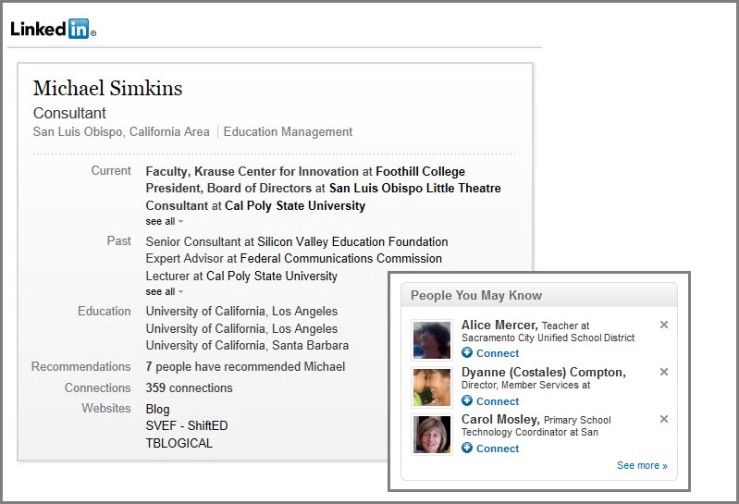I’ve been a member of LinkedIn for a number of years. When friends who don’t use the site learn that I do, they often appear puzzled and ask, “Why?’
Good question. I sometimes wonder about that myself, especially when I’m reviewing my credit card statement at the end of each month and see the $19.95 fee I pay for an upgraded account. What do I get out of it? Does it help my personal learning? Facilitate communication? Strengthen my attachment to a professional community? Actually, I think so!
Should you, dear reader, be unfamiliar with LinkedIn, it is what is called a professional, as opposed to a social, online community. It serves as a huge, 24-7 networking event. When you join, you create a resume-like profile and let the world know what you’re generally interested in—making new contacts, renewing old acquaintances, consulting, finding a new job, and the like.
A basic activity on LinkedIn is to make “connections.” As in Facebook and marriage, people become connected only by mutual consent. When I first joined, most members worked in high tech, sales, or marketing fields. Over the years, though, the breadth of occupations represented as grown remarkably, and I’ve built up a stable of over 350 connections. These range from fellow educators to lawyers, business managers, and artists. Each of these people is someone I’ve worked with somehow, somewhere, or been introduced to by a friend or colleague we have in common. Occasionally I scan through my connections and, like looking up at the face of Heavenly Valley after you’ve skiied your way down to the base, it’s a rather satisfying and reassuring experience.
While I have not called upon this network often, when I have it has been very useful. Let me give you a recent example. I was doing informal research for an article on, “How, in a school setting, can you get the most value out of the technology you already have.” LinkedIn makes it very easy to communicate with ad hoc groups of your connections. I selected 50 and sent them a brief message that asked for an “off-the-top-of-the-head” answer to that question. Within 24 hours I received replies from nearly everyone from which I garnered all sorts of good ideas that served as the foundation for my article.
Periodic “updates” are another LinkedIn feature I find useful. These come to your mailbox on a schedule you choose. Like a beneficent tattler, they offer little tidbits on what your connections are up to. This one just got a new job. That one published a book or article. Another one is off to consult in Singapore. This offers a great opportunity for serendipitous discovery. I will often find someone doing something that’s either relevant to a current project or gives me an idea for a new one.
Despite its usefulness, LinkedIn can be a distraction and an annoyance. Updates on my connections’ activities land in my mailbox and I read them, even if at that moment it’s the last way I should be spending my time. Or I log in with the sole purpose of making a 5-minute update to my profile; the next thing I know I’ve spent 20 minutes perusing lists of “suggested connections” LinkedIn so thoughtfully provides. And annoying? I hate it when I get an “I’d like to add you to my LinkedIn connections” message from someone I’ve never heard of, only vaguely remember, or whom I do know and with whom I’d prefer not to be associated. Even though it is superbly easy to decline (just a simple click; no explanation needed), I can’t bring myself to do that. So I struggle to come up with some face-saving response or, worse, just leave the request unanswered in my queue where it gives me twinges of guilt every time I see it.
Reflecting on my experience with LinkedIn leads me to think more generally about how the Internet has impacted my personal learning as well as that of my adult students. For me, it’s my own personal, instant, world-wide library. It provides easy, deliberate access to peers, friends, and colleagues. It enables serendipitous discovery by providing a continuous information flow. The Internet also distracts me, enables if not encourages procrastination, and deters if not disables deep thinking.
I suspect that the adults I teach experience similar effects. However, testing that hunch will be an important first step in working with any new group of students. Such a test would include some simple survey questions as well as class discussion designed to draw out the various ways people structure their time on the Internet to enhance its usefulness, overcome distractions and other drawbacks, and cope with the negative aspects beyond their control. From such a discussion could emerge a very useful list of suggested components for a personal online learning space and guidelines for constructing and using it.


LInkedIn has never quite made sense to me, in terms of what I might gain by being “linked in”. Dr. Simkins’ explanation and illustrations make me understand the benefits for the first time. Most enlightening.